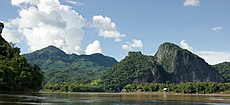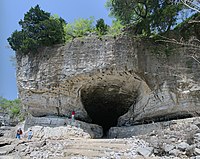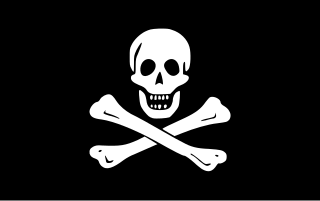
Piracy is an act of robbery or criminal violence by ship or boat-borne attackers upon another ship or a coastal area, typically with the goal of stealing cargo and other valuable goods. Those who conduct acts of piracy are called pirates, vessels used for piracy are pirate ships. The earliest documented instances of piracy were in the 14th century BC, when the Sea Peoples, a group of ocean raiders, attacked the ships of the Aegean and Mediterranean civilisations. Narrow channels which funnel shipping into predictable routes have long created opportunities for piracy, as well as for privateering and commerce raiding.

Cave-In-Rock is a village in Hardin County, Illinois, United States. Its principal feature and tourist attraction is nearby Cave-In-Rock, on the banks of the Ohio River. In 1816, the earliest known permanent white settlers arrived and started building a town near the cave. The town was originally known as Rock and Cave, Illinois, with a post office under this name. On October 24, 1849, the town was officially renamed Cave-In-Rock. Cave-In-Rock was incorporated as a village in 1901. The population was 318 at the 2010 census.
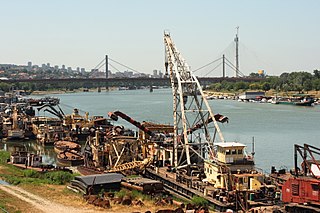
A riverboat is a watercraft designed for inland navigation on lakes, rivers, and artificial waterways. They are generally equipped and outfitted as work boats in one of the carrying trades, for freight or people transport, including luxury units constructed for entertainment enterprises, such as lake or harbour tour boats. As larger water craft, virtually all riverboats are especially designed and constructed, or alternatively, constructed with special-purpose features that optimize them as riverine or lake service craft, for instance, dredgers, survey boats, fisheries management craft, fireboats and law enforcement patrol craft.

The Yangtze Patrol, also known as the Yangtze River Patrol Force, Yangtze River Patrol, YangPat and ComYangPat, was a prolonged naval operation from 1854–1949 to protect American interests in the Yangtze River's treaty ports. The Yangtze Patrol also patrolled the coastal waters of China where they protected U.S. citizens, their property, and Christian missionaries.

James Ford, born James N. Ford, also known as James N. Ford, Sr., the "N" possibly for Neal, was an American civic leader and business owner in western Kentucky and southern Illinois, from the late 1790s to mid-1830s. Despite his clean public image as a "Pillar of the Community", Ford was secretly a river pirate and the leader of a gang that was later known as the "Ford's Ferry Gang". His men were the river equivalent of highway robbers. They hijacked flatboats and Ford's "own river ferry" for tradable goods from local farms that were coming down the Ohio River.

Micajah "Big" Harpe, born Joshua Harper, and Wiley "Little" Harpe, born William Harper, were American murderers, highwaymen and river pirates who operated in Tennessee, Kentucky, Illinois and Mississippi in the late 18th century. They are often considered the earliest documented serial killers in the United States history.
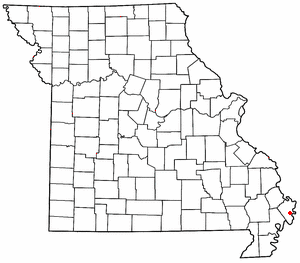
Wolf Island is an unincorporated community in eastern Mississippi County, Missouri, United States. It is located on Route 77, approximately nine miles east of East Prairie.

Piracy in the Strait of Malacca has long been a threat to ship owners and the mariners who ply the 900 km-long sea lane. In recent years, coordinated patrols by Indonesia, Malaysia, Thailand, and Singapore along with increased security on vessels have sparked a sharp downturn in piracy.

Samuel Ross Mason, also spelled Meason, was a Virginia militia captain, on the American western frontier, during the American Revolutionary War. After the war, he became the leader of the Mason Gang, a criminal gang of river pirates and highwaymen on the lower Ohio River and the Mississippi River in the late 18th and early 19th centuries. He was associated with outlaws around Red Banks, Cave-in-Rock, Stack Island, and the Natchez Trace.

Natchez has been the name of several steamboats, and four naval vessels, each named after the city of Natchez, Mississippi or the Natchez people. The current one has been in operation since 1975. The previous Natchez were all operated in the nineteenth century, most by Captain Thomas P. Leathers. Each of the steamboats since Leathers' first had as its ensign a cotton bale between its stacks.

The Sturdivant Gang was a multi-generational, family gang of counterfeiters, whose criminal activities took place over a fifty-year period, from the 1780s, in Connecticut and Massachusetts, with one branch of the family going to Tennessee via Virginia and a second family branch going to Ohio and finally settled on the Illinois frontier, between the 1810s to 1830s.

John Duff, born John McElduff, or John Michael McElduff, because early court records referred to him as John Michael Duff, was a counterfeiter, criminal gang leader, horse thief, cattle thief, hog thief, salt maker, longhunter, scout, and soldier who assisted in George Rogers Clark's campaign to capture the Illinois country for the American rebel side during the Revolutionary War.
Philip Alston was an 18th-century Spanish-American counterfeiter, both before and after the American Revolution. He operated in Virginia and the Carolinas before the war, and in Kentucky and Illinois afterward. He was associated with Cave-in-Rock and his son, outlaw Peter Alston, and counterfeiter John Duff. He was an early American settler in Natchez, as well as in the Cumberland and Red River valleys in Kentucky and Tennessee.
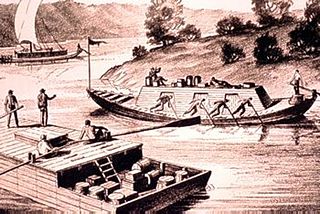
Diamond Island is an island in the Ohio River ten miles west of Henderson in Henderson County, Kentucky, United States. It has an area of about half a square mile.
Piracy in Indonesia is not only notorious, but according to a survey conducted by the International Maritime Bureau, it was also the country sporting the highest rate of pirate attacks back in 2004, where it subsequently dropped to second place of the world's worst country of pirate attacks in 2008, finishing just behind Nigeria. However, Indonesia is still deemed the country with the world's most dangerous water due to its high piracy rate. With more than half of the world's piracy crimes surrounding the South-East Asia aquatic regions, the turmoil caused by piracy has made the Strait of Malacca a distinct pirate hotspot accounting for most of the attacks in Indonesia, making the ships that sail in this region risky ever since the Europeans arrived. The term 'Piracy in Indonesia' includes both cases of Indonesian pirates hijacking other cargo and tanks, as well as the high rate of practising piracy within the country itself. The Strait of Malacca is also one of the world's busiest shipping routes as it accounts for more than twenty-five percent of the world's barter goods that come mainly from China and Japan. Approximately 50,000 vessels worth of the world's trade employ the strait annually, including oil from the Persian Gulf and manufactured goods to the Middle East and Suez Canal. The success that stems from this trade portal makes the Strait an ideal location for pirate attacks.
Peter Alston was an American counterfeiter, horse thief, highwayman, and river pirate of the late 18th and early 19th centuries. He is believed to have been an associate of serial killer Little Harpe, and a member of the notorious Mason Gang.

Stack Island, also known as Crow's Nest and Island No. 94, is located in Issaquena County, Mississippi, in the Mississippi River, near Lake Providence, Louisiana and nearly 200 miles north of New Orleans.

The Patsey Conroy Gang or Patsy Conroys were a group of river pirates active along the New York City waterfront of the old Fourth Ward during the post-American Civil War era. For nearly twenty years the Patsy Conroys dominated the area of Corlears' Hook and were one of the last major waterfront gangs to remain in the district prior to the formation of the George Gastlin's Steamboat Squad of New York City Police Department. The Patsey Conroy Gang abruptly disappeared when their leaders Patsy Conroy, Larry Griffin and Denny Brady were imprisoned in 1874.
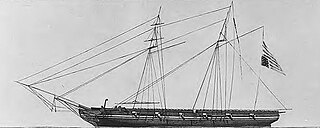
The West Indies Anti-Piracy Operations refer to the United States Navy presence in the Antilles, and surrounding waters, which fought against pirates. Between 1814 and 1825, the American West Indies Squadron constantly pursued pirates on sea and land, primarily around Cuba and Puerto Rico.After the capture of Roberto Cofresi in 1825, acts of piracy became rare, and the operation was considered a success, although limited occurrences went on until slightly after the start of the 20th century.

Colonel Plug, also known as Colonel Fluger and "The Last of the Boat-Wreckers", who existed sometime between the 1790s and 1820, was the legendary river pirate who ran a criminal gang on the Ohio River in a cypress swamp near the mouth of the Cache River. The outlaw camp of Colonel Plug was supposedly below the river pirate hideout of Cave-In-Rock and the U.S. Army post at Fort Massac, which monitored and policed frontier river traffic just above the confluence of the Ohio and Mississippi Rivers.


